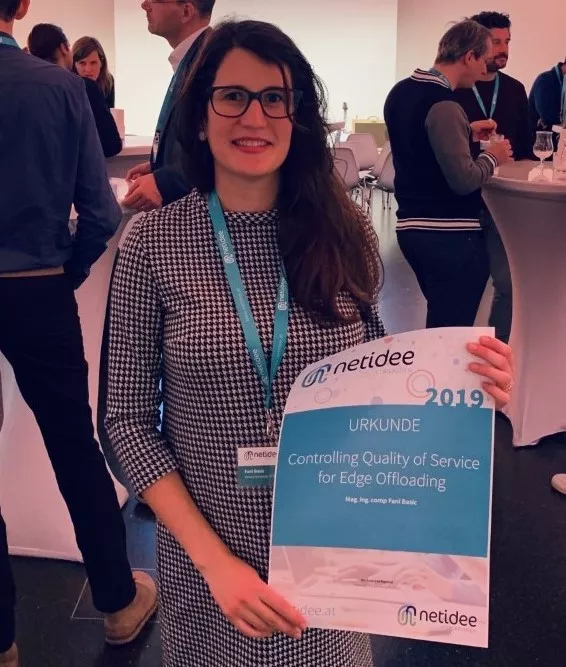
Förderjahr / / ProjektID: / Projekt: Efficient offloading architecture model
In the proposed architecture model, we use the feedback control loop. Based on the measured system QoS, feedback loop gives the opportunity to almost instantaneously adjust system towards meeting the desired system performance.
In addition to our previous blog post when we introduced edge node selection and handoff control as main parts of our offloading model, now we give the implementation and technical details of used technologies.
Fuzzy logic-based algorithm
Fuzzy logic, unlike classical Boolean logic, supports multiple intermediate values for attributes, rather than restricting them to binary extremes. This makes fuzzy inference systems effective in dealing with uncertainties and imperfect information among multiple input variables. Fuzzy reasoning mechanism consists of three steps: fuzzification, inference engine and defuzzification, as shown in Fig 1.
In the fuzzy decision algorithm for node selection we propose, three input parameters are used, namely: bandwidth capacity (BW), processing power (CPU), and latency (LAT). The edge node with the highest fuzzy output value is the most suitable to execute the offloaded task. During fuzzification, input parameters are collected and mapped to relevant fuzzy sets with a degree of membership between 0 and 1 using the membership functions (MF) curve. We use Gaussian MF to define input variables for each of the three associated linguistic levels: low (L), medium (M), and high (H), for all the inputs: BW, CPU, and LAT. In addition, following triangular membership functions are used to represent the output: Highly Undesirable, Undesirable, Neutral, Desirable, Highly Desirable. The inference engine infers the fuzzy output from the defined fuzzy inputs through the if-then rule evaluation. In our case, considering three possible values (L, M, H) for three inputs, we obtain 3^3possible rule combinations.
Using these rules, an example of the reasoning process can be expressed as follows: if the BW is high, CPU is high, and LAT is medium, then consider this location as highly desirable for task offloading.
In the defuzzification step, the degree of membership of the output linguistic variables are converted to a resulting crisp output value. We use the widely accepted defuzzification method center of gravity.

Control loop architecture
In a standard feedback control loop architecture (Fig 2.), the controller periodically adapts the value of its output, to reduce or eliminate the error. The error (ei) is the difference between the reference input and measured output, strongly affected by the uncontrollable disturbances in the target system. In our approach, disturbances are the sudden changes in the traffic load, network and hardware failures as well as user mobility. Despite disturbances, system - mobile applications are expected to provide certain performance guarantees. For example, response time (RT) has strong impact on user satisfaction. Therefore, we define the desired RT, as a reference input in our model predefined by the developer, user or provider. Whereas, the measured RT is the application’s RT and it is used as a feedback variable. The difference between these two values is the control error. We computed the controller output ctli, which is the system input, using equation:

The system model parameter α is estimated at each control interval based on the effect of the ctli on the measured RT, (αi = rti/ctli). Tunable parameter called pole [0-1], influences the stability of the controlled system, and determines how fast the system approaches to its equilibrium. The closer the pole is to 0, the shorter is the settling time. On the contrary, setting the pole close to 1 does smaller adjustments of the control output and takes smaller steps towards the goal.

Conclusion
Using this approach, first we demonstrate that the fuzzy logic node selection can minimize the application response time, as node selection also affects the number of handoffs made during the application execution. Then through exhaustive simulation, we show the benefits our controller brings in reducing the monetary cost by avoiding frequent handoffs for different configurations (virtual machines and containers). More detailed numerical results overview can be found in [1].
[1] Fani Basic, Atakan Aral and Ivona Brandic. Fuzzy Handoff Control in Edge Offloading. IEEE International Conference on Fog Computing (ICFC 2019). Prague, Czech Republic, June 24-26, 2019.


